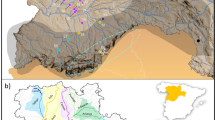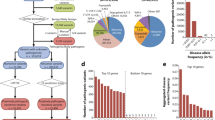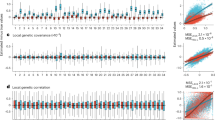Abstract
Population isolates are a valuable resource for medical genetics because of their reduced genetic, phenotypic and environmental heterogeneity. Further, extended linkage disequilibrium (LD) allows accurate haplotyping and imputation. In this study, we use nuclear and mitochondrial DNA data to determine to what extent the geographically isolated population of the Val Borbera valley also presents features of genetic isolation. We performed a comparative analysis of population structure and estimated effective population size exploiting LD data. We also evaluated haplotype sharing through the analysis of segments of autozygosity. Our findings reveal that the valley has features characteristic of a genetic isolate, including reduced genetic heterogeneity and reduced effective population size. We show that this population has been subject to prolonged genetic drift and thus we expect many variants that are rare in the general population to reach significant frequency values in the valley, making this population suitable for the identification of rare variants underlying complex traits.
Similar content being viewed by others
Log in or create a free account to read this content
Gain free access to this article, as well as selected content from this journal and more on nature.com
or
References
Holm H, Gudbjartsson DF, Sulem P et al. A rare variant in MYH6 is associated with high risk of sick sinus syndrome. Nat Genet 2011; 43: 316–320.
Sulem P, Gudbjartsson DF, Walters GB et al. Identification of low-frequency variants associated with gout and serum uric acid levels. Nat Genet 2011; 43: 1127–1130.
Thorgeirsson TE, Oskarsson H, Desnica N et al. Anxiety with panic disorder linked to chromosome 9q in Iceland. Am J Hum Genet 2003; 72: 1221–1230.
Kristiansson K, Naukkarinen J, Peltonen L : Isolated populations and complex disease gene identification. Genome Biol 2008; 9: 109.
Peltonen L, Palotie A, Lange K : Use of population isolates for mapping complex traits. Nat Rev Genet 2000; 1: 182–190.
Charlesworth B : Fundamental concepts in genetics: effective population size and patterns of molecular evolution and variation. Nat Rev Genet 2009; 10: 195–205.
Manolio TA, Collins FS, Cox NJ et al. Finding the missing heritability of complex diseases. Nature 2009; 461: 747–753.
Service S, DeYoung J, Karayiorgou M et al. Magnitude and distribution of linkage disequilibrium in population isolates and implications for genome-wide association studies. Nat Genet 2006; 38: 556–560.
Kong A, Masson G, Frigge ML et al. Detection of sharing by descent, long-range phasing and haplotype imputation. Nat Genet 2008; 40: 1068–1075.
Marchini J, Howie B : Genotype imputation for genome-wide association studies. Nat Rev Genet 2010; 11: 499–511.
Palin K, Campbell H, Wright AF, Wilson JF, Durbin R : Identity-by-descent-based phasing and imputation in founder populations using graphical models. Genet Epidemiol 2011; 35: 853–860.
Traglia M, Sala C, Masciullo C et al. Heritability and demographic analyses in the large isolated population of Val Borbera suggest advantages in mapping complex traits genes. PLoS One 2009; 4: e7554.
Milani G, Masciullo C, Sala C et al. Computer-based genealogy reconstruction in founder populations. Biomed Inform 2011; 44: 997–1003.
Pemberton TJ, Wang C, Li JZ, Rosenberg NA : Inference of unexpected genetic relatedness among individuals in HapMap Phase III. Am J Hum Genet 2010; 87: 457–464.
Gambaro G, Yabarek T, Graziani MS et al. Prevalence of CKD in northeastern Italy: results of the INCIPE study and comparison with NHANES. Clin J Am Soc Nephrol 2010; 5: 1946–1953.
Tambets K, Rootsi S, Kivisild T et al. The western and eastern roots of the Saami--the story of genetic ‘outliers’ told by mitochondrial DNA and Y chromosomes. Am J Hum Genet 2004; 74: 661–682.
Altshuler DM, Gibbs RA, Peltonen L et al. Integrating common and rare genetic variation in diverse human populations. Nature 2010; 467: 52–58.
Graziani MS, Gambaro G, Mantovani L et al. Diagnostic accuracy of a reagent strip for assessing urinary albumin excretion in the general population. Nephrol Dial Transplant 2009; 24: 1490–1494.
Holsinger KE, Weir BS : Genetics in geographically structured populations: defining, estimating and interpreting F(ST). Nat Rev Genet 2009; 10: 639–650.
Patterson N, Price AL, Reich D : Population structure and eigenanalysis. PLoS Genet 2006; 2: e190.
Alexander DH, Novembre J, Lange K : Fast model-based estimation of ancestry in unrelated individuals. Genome Res 2009; 19: 1655–1664.
Bellenguez C, Ober C, Bourgain C : Linkage analysis with dense SNP maps in isolated populations. Hum Hered 2009; 68: 87–97.
Price AL, Patterson NJ, Plenge RM, Weinblatt ME, Shadick NA, Reich D : Principal components analysis corrects for stratification in genome-wide association studies. Nat Genet 2006; 38: 904–909.
McVean G : A genealogical interpretation of principal components analysis. PLoS Genet 2009; 5: e1000686.
Purcell S, Neale B, Todd-Brown K et al. PLINK: a tool set for whole-genome association and population-based linkage analyses. Am J Hum Genet 2007; 81: 559–575.
McEvoy BP, Powell JE, Goddard ME, Visscher PM : Human population dispersal ‘Out of Africa’ estimated from linkage disequilibrium and allele frequencies of SNPs. Genome Res 2011; 21: 821–829.
Tenesa A, Navarro P, Hayes BJ et al. Recent human effective population size estimated from linkage disequilibrium. Genome Res 2007; 17: 520–526.
Hayes BJ, Visscher PM, McPartlan HC, Goddard ME : Novel multilocus measure of linkage disequilibrium to estimate past effective population size. Genome Res 2003; 13: 635–643.
Fenner JN : Cross-cultural estimation of the human generation interval for use in genetics-based population divergence studies. Am J Phys Anthropol 2005; 128: 415–423.
Achilli A, Olivieri A, Pala M et al. Mitochondrial DNA backgrounds might modulate diabetes complications rather than T2DM as a whole. PLoS One 2011; 6: e21029.
Drummond AJ, Rambaut A : BEAST: Bayesian evolutionary analysis by sampling trees. BMC Evol Biol 2007; 7: 214.
Hasegawa M, Kishino H, Yano T : Dating of the human-ape splitting by a molecular clock of mitochondrial DNA. J Mol Evol 1985; 22: 160–174.
Heled J, Drummond AJ : Bayesian inference of population size history from multiple loci. BMC Evol Biol 2008; 8: 289.
Forster P, Harding R, Torroni A, Bandelt HJ : Origin and evolution of Native American mtDNA variation: a reappraisal. Am J Hum Genet 1996; 59: 935–945.
Frazer KA, Ballinger DG, Cox DR et al. A second generation human haplotype map of over 3.1 million SNPs. Nature 2007; 449: 851–861.
Lencz T, Lambert C, DeRosse P et al. Runs of homozygosity reveal highly penetrant recessive loci in schizophrenia. Proc Natl Acad Sci USA 2007; 104: 19942–19947.
McQuillan R, Leutenegger AL, Abdel-Rahman R et al. Runs of homozygosity in European populations. Am J Hum Genet 2008; 83: 359–372.
Kirin M, McQuillan R, Franklin CS, Campbell H, McKeigue PM, Wilson JF : Genomic runs of homozygosity record population history and consanguinity. PLoS One 2010; 5: e13996.
Colonna V, Nutile T, Astore M et al. Campora: a young genetic isolate in South Italy. Hum Hered 2007; 64: 123–135.
Gravel S, Henn BM, Gutenkunst RN et al. Demographic history and rare allele sharing among human populations. Proc Natl Acad Sci USA 2011; 108: 11983–11988.
Gutenkunst RN, Hernandez RD, Williamson SH, Bustamante CD : Inferring the joint demographic history of multiple populations from multidimensional SNP frequency data. PLoS Genet 2009; 5: e1000695.
Soares P, Achilli A, Semino O et al. The archaeogenetics of Europe. Curr Biol 2010; 20: R174–R183.
Nelis M, Esko T, Magi R et al. Genetic structure of Europeans: a view from the North-East. PLoS One 2009; 4: e5472.
O'Dushlaine CT, Morris D, Moskvina V et al. Population structure and genome-wide patterns of variation in Ireland and Britain. Eur J Hum Genet 2010; 18: 1248–1254.
Colonna V, Nutile T, Ferrucci RR et al. Comparing population structure as inferred from genealogical versus genetic information. Eur J Hum Genet 2009; 17: 1635–1641.
Wakeley J, Aliacar N : Gene genealogies in a metapopulation. Genetics 2001; 159: 893–905.
De A, Durrett R : Stepping-stone spatial structure causes slow decay of linkage disequilibrium and shifts the site frequency spectrum. Genetics 2007; 176: 969–981.
Ray N, Currat M, Excoffier L : Intra-deme molecular diversity in spatially expanding populations. Mol Biol Evol 2003; 20: 76–86.
Stadler T, Haubold B, Merino C, Stephan W, Pfaffelhuber P : The impact of sampling schemes on the site frequency spectrum in nonequilibrium subdivided populations. Genetics 2009; 182: 205–216.
Wakeley J : Nonequilibrium migration in human history. Genetics 1999; 153: 1863–1871.
Gieger C, Radhakrishnan A, Cvejic A et al. New gene functions in megakaryopoiesis and platelet formation. Nature 2011; 480: 201–208.
Nalls MA, Couper DJ, Tanaka T et al. Multiple loci are associated with white blood cell phenotypes. PLoS Genet 2011; 7: e1002113.
Wain LV, Verwoert GC, O’Reilly PF et al. Genome-wide association study identifies six new loci influencing pulse pressure and mean arterial pressure. Nat Genet 2011; 43: 1005–1011.
Acknowledgements
This research received support from Fondazione Alma Mater Ticinensis (to AT), the Italian Ministry of the University FIRB-Futuro in Ricerca 2008 (to AA) and Progetti Ricerca Interesse Nazionale 2009 (to AA and AT), Compagnia di San Paolo, Torino, Fondazione Cariplo, Milano and Health Ministry Progetto Finalizzato (to DT). We would like to thank the inhabitants and the administrators of the Val Borbera for their kind participation in the study. A special thanks to Professor Clara Camaschella, Dr Silvia Bione, Dr Laura Crocco, Ms Maria Rosa Biglieri, Dr Diego Sabbi for help with the data collection, to Dr Gabriella Parodi, Dr Laura Gaggiano and the Cooperatova ARCA (Al) for help with the church archives. We acknowledge Professor Guido Barbujani, Professor Alberto Piazza, Professor Chris Tyler-Smith and Dr Kimmo Palin and two anonymous reviewers for valuable suggestions and comments on the manuscript.
Author information
Authors and Affiliations
Corresponding author
Ethics declarations
Competing interests
The authors declare no conflict of interest.
Additional information
Supplementary Information accompanies the paper on European Journal of Human Genetics website
Supplementary information
Rights and permissions
About this article
Cite this article
Colonna, V., Pistis, G., Bomba, L. et al. Small effective population size and genetic homogeneity in the Val Borbera isolate. Eur J Hum Genet 21, 89–94 (2013). https://doi.org/10.1038/ejhg.2012.113
Received:
Revised:
Accepted:
Published:
Issue date:
DOI: https://doi.org/10.1038/ejhg.2012.113
Keywords
This article is cited by
-
Characterization of Danube Swabian population samples on a high-resolution genome-wide basis
BMC Genomics (2023)
-
Design and validation of a 63K genome-wide SNP-genotyping platform for caribou/reindeer (Rangifer tarandus)
BMC Genomics (2022)
-
Evidence for penetrance in patients without a family history of disease: a systematic review
European Journal of Human Genetics (2020)
-
Overcoming the dichotomy between open and isolated populations using genomic data from a large European dataset
Scientific Reports (2017)
-
Enrichment of low-frequency functional variants revealed by whole-genome sequencing of multiple isolated European populations
Nature Communications (2017)



